HSC210 Health Essay: Neo-liberalism's Effect on Indigenous Health
VerifiedAdded on 2023/04/03
|15
|2747
|309
Essay
AI Summary
This essay explores the effects of neo-liberal policies on the health outcomes of Indigenous Australians, utilizing sociological theories such as Durkheim's theory of social change and Marx's power theory. It argues that neo-liberalism, with its emphasis on free-market principles and reduced government intervention, negatively impacts the health of Indigenous communities by exacerbating inequalities and hindering access to healthcare. The essay highlights how privatization and the prioritization of individual rights over collective well-being challenge efforts to close the health gap between Indigenous and non-Indigenous Australians. Furthermore, it discusses the implications for health practitioners and the importance of acknowledging and respecting Indigenous cultures and traditional healing practices.
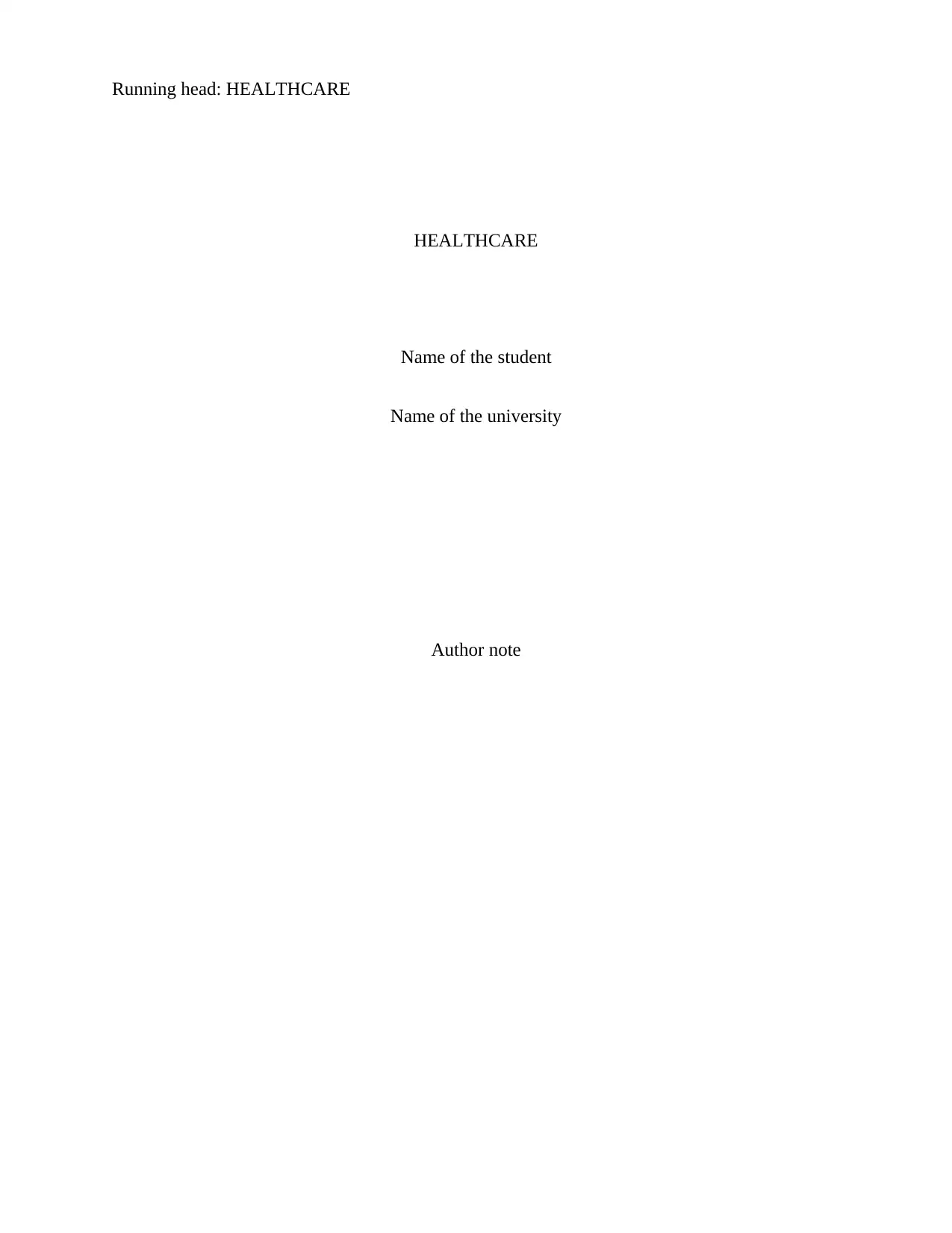
Running head: HEALTHCARE
HEALTHCARE
Name of the student
Name of the university
Author note
HEALTHCARE
Name of the student
Name of the university
Author note
Paraphrase This Document
Need a fresh take? Get an instant paraphrase of this document with our AI Paraphraser
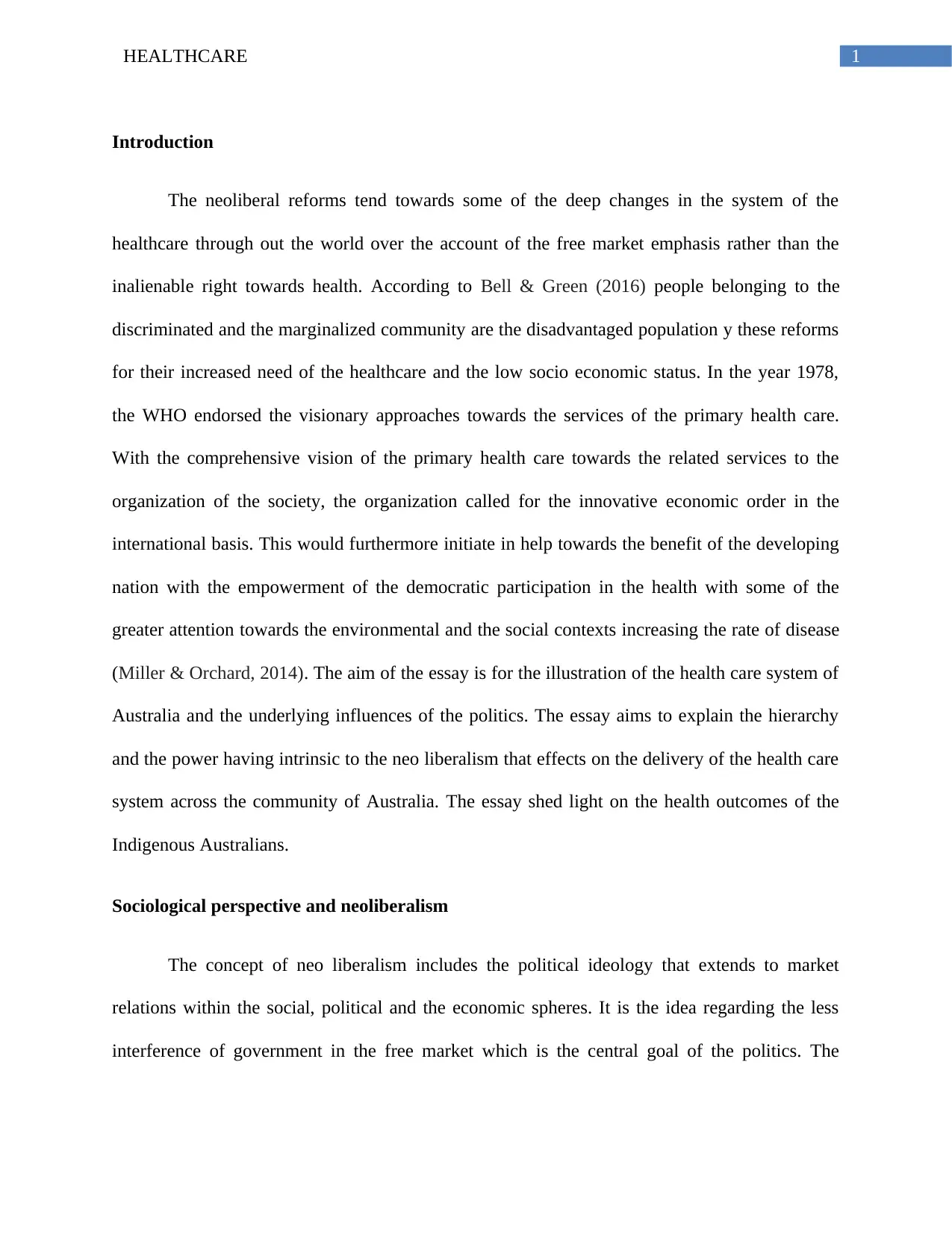
HEALTHCARE 1
Introduction
The neoliberal reforms tend towards some of the deep changes in the system of the
healthcare through out the world over the account of the free market emphasis rather than the
inalienable right towards health. According to Bell & Green (2016) people belonging to the
discriminated and the marginalized community are the disadvantaged population y these reforms
for their increased need of the healthcare and the low socio economic status. In the year 1978,
the WHO endorsed the visionary approaches towards the services of the primary health care.
With the comprehensive vision of the primary health care towards the related services to the
organization of the society, the organization called for the innovative economic order in the
international basis. This would furthermore initiate in help towards the benefit of the developing
nation with the empowerment of the democratic participation in the health with some of the
greater attention towards the environmental and the social contexts increasing the rate of disease
(Miller & Orchard, 2014). The aim of the essay is for the illustration of the health care system of
Australia and the underlying influences of the politics. The essay aims to explain the hierarchy
and the power having intrinsic to the neo liberalism that effects on the delivery of the health care
system across the community of Australia. The essay shed light on the health outcomes of the
Indigenous Australians.
Sociological perspective and neoliberalism
The concept of neo liberalism includes the political ideology that extends to market
relations within the social, political and the economic spheres. It is the idea regarding the less
interference of government in the free market which is the central goal of the politics. The
Introduction
The neoliberal reforms tend towards some of the deep changes in the system of the
healthcare through out the world over the account of the free market emphasis rather than the
inalienable right towards health. According to Bell & Green (2016) people belonging to the
discriminated and the marginalized community are the disadvantaged population y these reforms
for their increased need of the healthcare and the low socio economic status. In the year 1978,
the WHO endorsed the visionary approaches towards the services of the primary health care.
With the comprehensive vision of the primary health care towards the related services to the
organization of the society, the organization called for the innovative economic order in the
international basis. This would furthermore initiate in help towards the benefit of the developing
nation with the empowerment of the democratic participation in the health with some of the
greater attention towards the environmental and the social contexts increasing the rate of disease
(Miller & Orchard, 2014). The aim of the essay is for the illustration of the health care system of
Australia and the underlying influences of the politics. The essay aims to explain the hierarchy
and the power having intrinsic to the neo liberalism that effects on the delivery of the health care
system across the community of Australia. The essay shed light on the health outcomes of the
Indigenous Australians.
Sociological perspective and neoliberalism
The concept of neo liberalism includes the political ideology that extends to market
relations within the social, political and the economic spheres. It is the idea regarding the less
interference of government in the free market which is the central goal of the politics. The
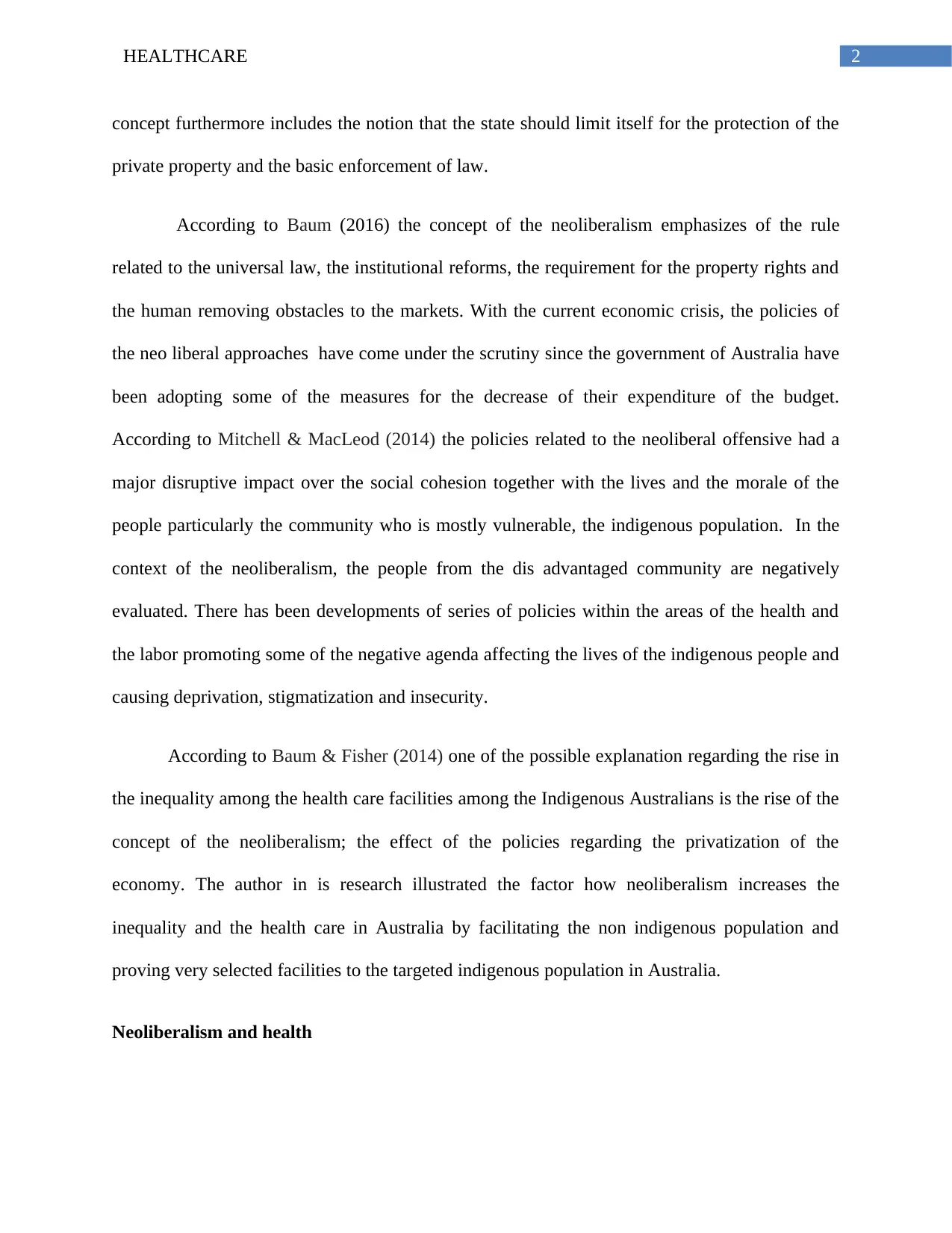
2HEALTHCARE
concept furthermore includes the notion that the state should limit itself for the protection of the
private property and the basic enforcement of law.
According to Baum (2016) the concept of the neoliberalism emphasizes of the rule
related to the universal law, the institutional reforms, the requirement for the property rights and
the human removing obstacles to the markets. With the current economic crisis, the policies of
the neo liberal approaches have come under the scrutiny since the government of Australia have
been adopting some of the measures for the decrease of their expenditure of the budget.
According to Mitchell & MacLeod (2014) the policies related to the neoliberal offensive had a
major disruptive impact over the social cohesion together with the lives and the morale of the
people particularly the community who is mostly vulnerable, the indigenous population. In the
context of the neoliberalism, the people from the dis advantaged community are negatively
evaluated. There has been developments of series of policies within the areas of the health and
the labor promoting some of the negative agenda affecting the lives of the indigenous people and
causing deprivation, stigmatization and insecurity.
According to Baum & Fisher (2014) one of the possible explanation regarding the rise in
the inequality among the health care facilities among the Indigenous Australians is the rise of the
concept of the neoliberalism; the effect of the policies regarding the privatization of the
economy. The author in is research illustrated the factor how neoliberalism increases the
inequality and the health care in Australia by facilitating the non indigenous population and
proving very selected facilities to the targeted indigenous population in Australia.
Neoliberalism and health
concept furthermore includes the notion that the state should limit itself for the protection of the
private property and the basic enforcement of law.
According to Baum (2016) the concept of the neoliberalism emphasizes of the rule
related to the universal law, the institutional reforms, the requirement for the property rights and
the human removing obstacles to the markets. With the current economic crisis, the policies of
the neo liberal approaches have come under the scrutiny since the government of Australia have
been adopting some of the measures for the decrease of their expenditure of the budget.
According to Mitchell & MacLeod (2014) the policies related to the neoliberal offensive had a
major disruptive impact over the social cohesion together with the lives and the morale of the
people particularly the community who is mostly vulnerable, the indigenous population. In the
context of the neoliberalism, the people from the dis advantaged community are negatively
evaluated. There has been developments of series of policies within the areas of the health and
the labor promoting some of the negative agenda affecting the lives of the indigenous people and
causing deprivation, stigmatization and insecurity.
According to Baum & Fisher (2014) one of the possible explanation regarding the rise in
the inequality among the health care facilities among the Indigenous Australians is the rise of the
concept of the neoliberalism; the effect of the policies regarding the privatization of the
economy. The author in is research illustrated the factor how neoliberalism increases the
inequality and the health care in Australia by facilitating the non indigenous population and
proving very selected facilities to the targeted indigenous population in Australia.
Neoliberalism and health
⊘ This is a preview!⊘
Do you want full access?
Subscribe today to unlock all pages.

Trusted by 1+ million students worldwide
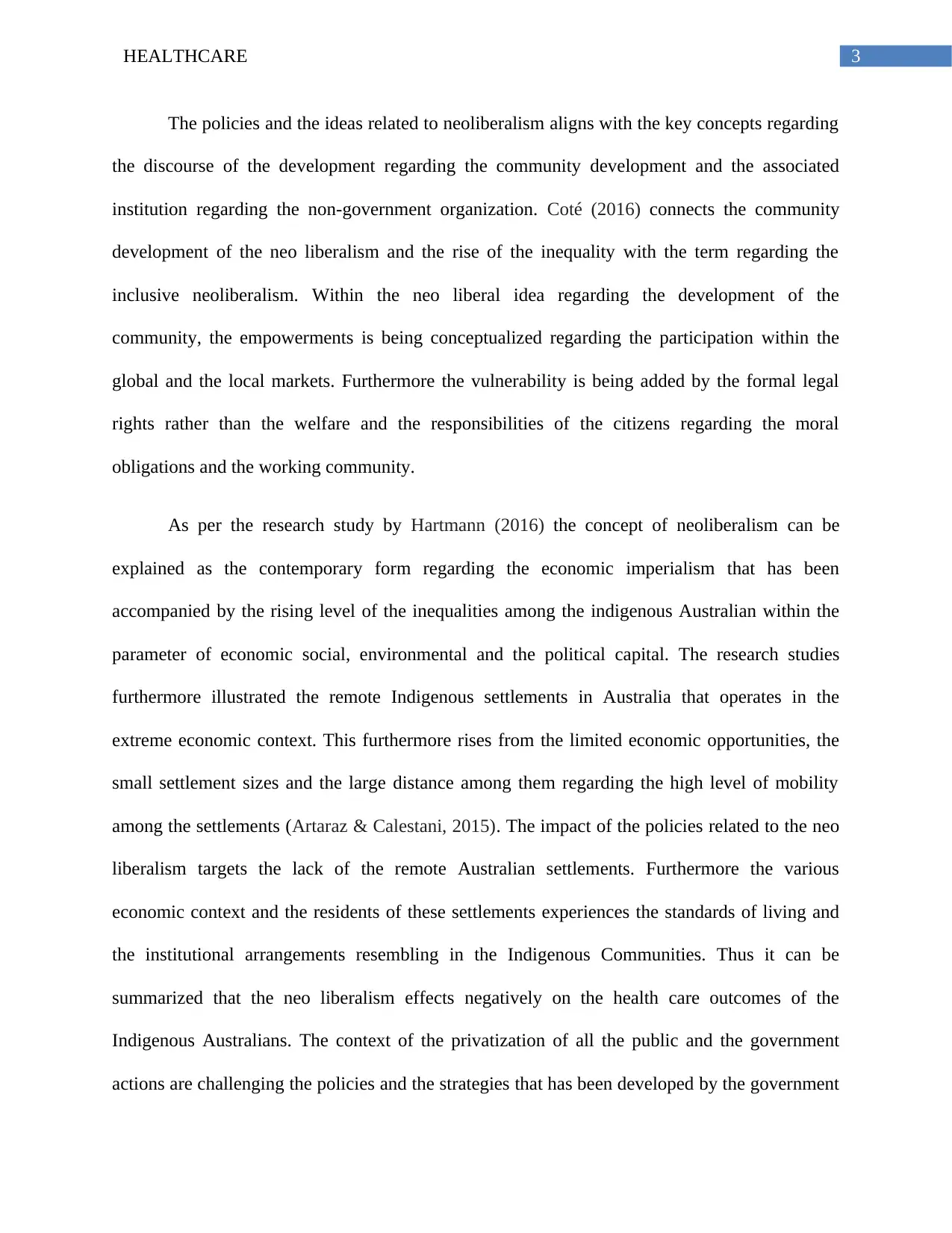
3HEALTHCARE
The policies and the ideas related to neoliberalism aligns with the key concepts regarding
the discourse of the development regarding the community development and the associated
institution regarding the non-government organization. Coté (2016) connects the community
development of the neo liberalism and the rise of the inequality with the term regarding the
inclusive neoliberalism. Within the neo liberal idea regarding the development of the
community, the empowerments is being conceptualized regarding the participation within the
global and the local markets. Furthermore the vulnerability is being added by the formal legal
rights rather than the welfare and the responsibilities of the citizens regarding the moral
obligations and the working community.
As per the research study by Hartmann (2016) the concept of neoliberalism can be
explained as the contemporary form regarding the economic imperialism that has been
accompanied by the rising level of the inequalities among the indigenous Australian within the
parameter of economic social, environmental and the political capital. The research studies
furthermore illustrated the remote Indigenous settlements in Australia that operates in the
extreme economic context. This furthermore rises from the limited economic opportunities, the
small settlement sizes and the large distance among them regarding the high level of mobility
among the settlements (Artaraz & Calestani, 2015). The impact of the policies related to the neo
liberalism targets the lack of the remote Australian settlements. Furthermore the various
economic context and the residents of these settlements experiences the standards of living and
the institutional arrangements resembling in the Indigenous Communities. Thus it can be
summarized that the neo liberalism effects negatively on the health care outcomes of the
Indigenous Australians. The context of the privatization of all the public and the government
actions are challenging the policies and the strategies that has been developed by the government
The policies and the ideas related to neoliberalism aligns with the key concepts regarding
the discourse of the development regarding the community development and the associated
institution regarding the non-government organization. Coté (2016) connects the community
development of the neo liberalism and the rise of the inequality with the term regarding the
inclusive neoliberalism. Within the neo liberal idea regarding the development of the
community, the empowerments is being conceptualized regarding the participation within the
global and the local markets. Furthermore the vulnerability is being added by the formal legal
rights rather than the welfare and the responsibilities of the citizens regarding the moral
obligations and the working community.
As per the research study by Hartmann (2016) the concept of neoliberalism can be
explained as the contemporary form regarding the economic imperialism that has been
accompanied by the rising level of the inequalities among the indigenous Australian within the
parameter of economic social, environmental and the political capital. The research studies
furthermore illustrated the remote Indigenous settlements in Australia that operates in the
extreme economic context. This furthermore rises from the limited economic opportunities, the
small settlement sizes and the large distance among them regarding the high level of mobility
among the settlements (Artaraz & Calestani, 2015). The impact of the policies related to the neo
liberalism targets the lack of the remote Australian settlements. Furthermore the various
economic context and the residents of these settlements experiences the standards of living and
the institutional arrangements resembling in the Indigenous Communities. Thus it can be
summarized that the neo liberalism effects negatively on the health care outcomes of the
Indigenous Australians. The context of the privatization of all the public and the government
actions are challenging the policies and the strategies that has been developed by the government
Paraphrase This Document
Need a fresh take? Get an instant paraphrase of this document with our AI Paraphraser
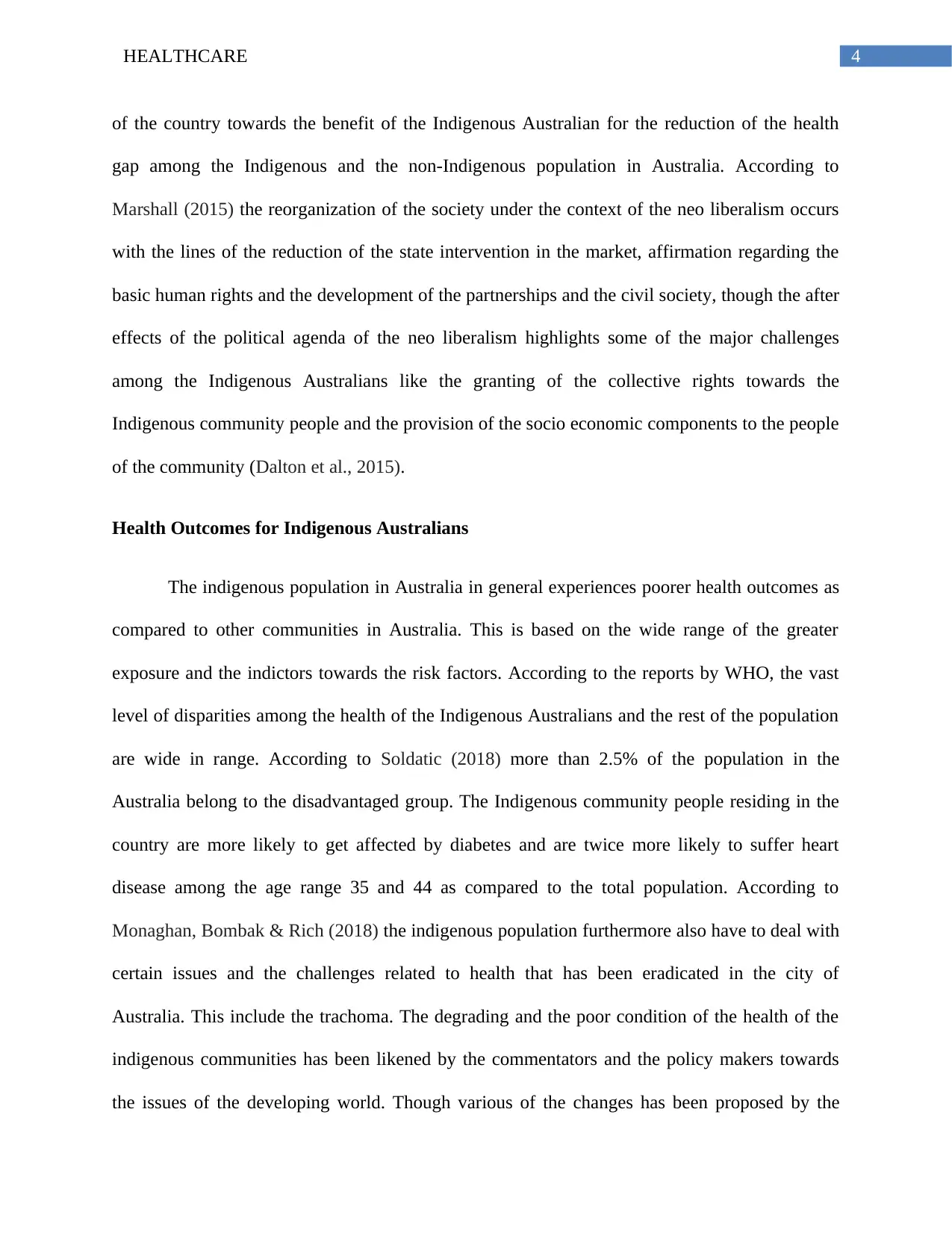
4HEALTHCARE
of the country towards the benefit of the Indigenous Australian for the reduction of the health
gap among the Indigenous and the non-Indigenous population in Australia. According to
Marshall (2015) the reorganization of the society under the context of the neo liberalism occurs
with the lines of the reduction of the state intervention in the market, affirmation regarding the
basic human rights and the development of the partnerships and the civil society, though the after
effects of the political agenda of the neo liberalism highlights some of the major challenges
among the Indigenous Australians like the granting of the collective rights towards the
Indigenous community people and the provision of the socio economic components to the people
of the community (Dalton et al., 2015).
Health Outcomes for Indigenous Australians
The indigenous population in Australia in general experiences poorer health outcomes as
compared to other communities in Australia. This is based on the wide range of the greater
exposure and the indictors towards the risk factors. According to the reports by WHO, the vast
level of disparities among the health of the Indigenous Australians and the rest of the population
are wide in range. According to Soldatic (2018) more than 2.5% of the population in the
Australia belong to the disadvantaged group. The Indigenous community people residing in the
country are more likely to get affected by diabetes and are twice more likely to suffer heart
disease among the age range 35 and 44 as compared to the total population. According to
Monaghan, Bombak & Rich (2018) the indigenous population furthermore also have to deal with
certain issues and the challenges related to health that has been eradicated in the city of
Australia. This include the trachoma. The degrading and the poor condition of the health of the
indigenous communities has been likened by the commentators and the policy makers towards
the issues of the developing world. Though various of the changes has been proposed by the
of the country towards the benefit of the Indigenous Australian for the reduction of the health
gap among the Indigenous and the non-Indigenous population in Australia. According to
Marshall (2015) the reorganization of the society under the context of the neo liberalism occurs
with the lines of the reduction of the state intervention in the market, affirmation regarding the
basic human rights and the development of the partnerships and the civil society, though the after
effects of the political agenda of the neo liberalism highlights some of the major challenges
among the Indigenous Australians like the granting of the collective rights towards the
Indigenous community people and the provision of the socio economic components to the people
of the community (Dalton et al., 2015).
Health Outcomes for Indigenous Australians
The indigenous population in Australia in general experiences poorer health outcomes as
compared to other communities in Australia. This is based on the wide range of the greater
exposure and the indictors towards the risk factors. According to the reports by WHO, the vast
level of disparities among the health of the Indigenous Australians and the rest of the population
are wide in range. According to Soldatic (2018) more than 2.5% of the population in the
Australia belong to the disadvantaged group. The Indigenous community people residing in the
country are more likely to get affected by diabetes and are twice more likely to suffer heart
disease among the age range 35 and 44 as compared to the total population. According to
Monaghan, Bombak & Rich (2018) the indigenous population furthermore also have to deal with
certain issues and the challenges related to health that has been eradicated in the city of
Australia. This include the trachoma. The degrading and the poor condition of the health of the
indigenous communities has been likened by the commentators and the policy makers towards
the issues of the developing world. Though various of the changes has been proposed by the
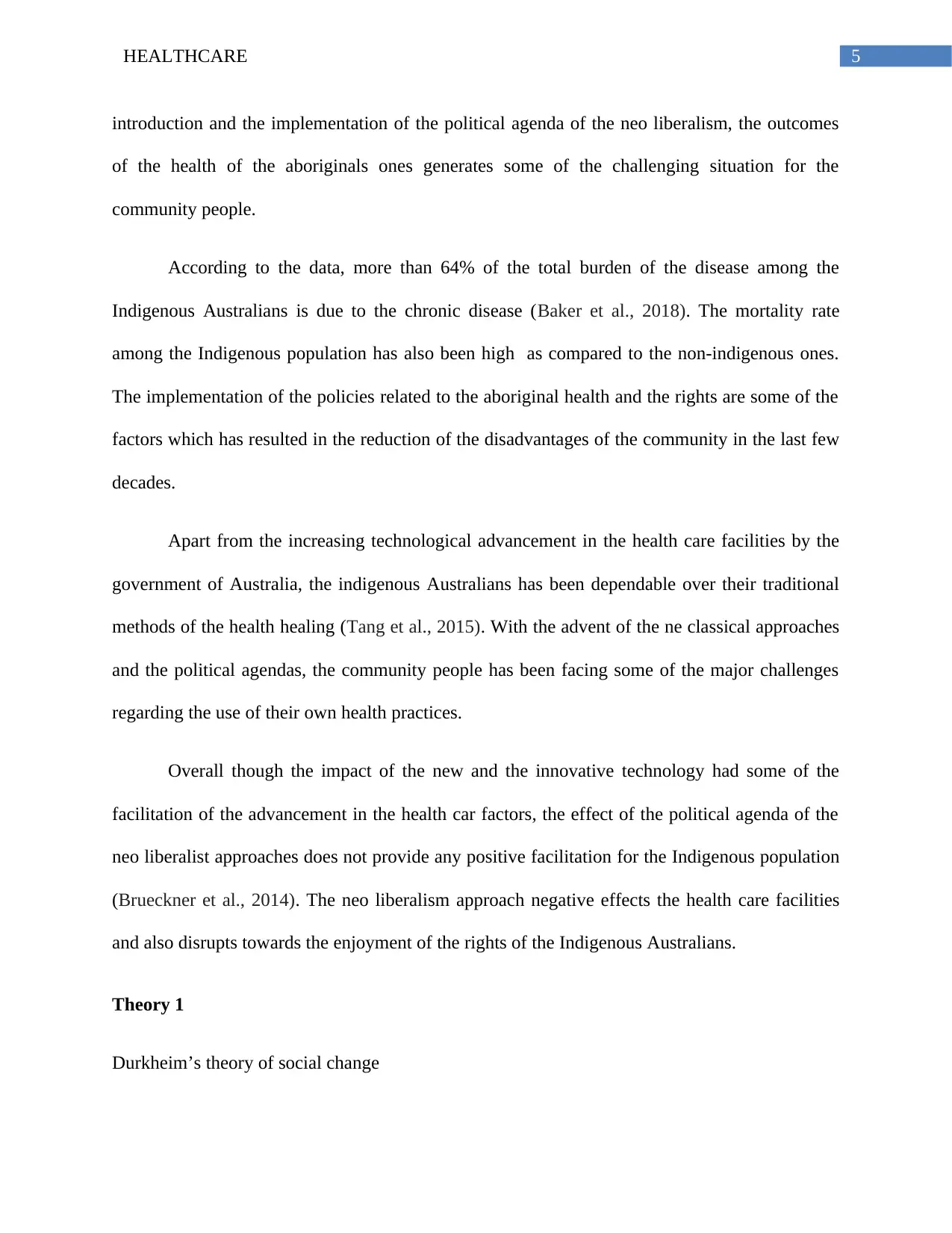
5HEALTHCARE
introduction and the implementation of the political agenda of the neo liberalism, the outcomes
of the health of the aboriginals ones generates some of the challenging situation for the
community people.
According to the data, more than 64% of the total burden of the disease among the
Indigenous Australians is due to the chronic disease (Baker et al., 2018). The mortality rate
among the Indigenous population has also been high as compared to the non-indigenous ones.
The implementation of the policies related to the aboriginal health and the rights are some of the
factors which has resulted in the reduction of the disadvantages of the community in the last few
decades.
Apart from the increasing technological advancement in the health care facilities by the
government of Australia, the indigenous Australians has been dependable over their traditional
methods of the health healing (Tang et al., 2015). With the advent of the ne classical approaches
and the political agendas, the community people has been facing some of the major challenges
regarding the use of their own health practices.
Overall though the impact of the new and the innovative technology had some of the
facilitation of the advancement in the health car factors, the effect of the political agenda of the
neo liberalist approaches does not provide any positive facilitation for the Indigenous population
(Brueckner et al., 2014). The neo liberalism approach negative effects the health care facilities
and also disrupts towards the enjoyment of the rights of the Indigenous Australians.
Theory 1
Durkheim’s theory of social change
introduction and the implementation of the political agenda of the neo liberalism, the outcomes
of the health of the aboriginals ones generates some of the challenging situation for the
community people.
According to the data, more than 64% of the total burden of the disease among the
Indigenous Australians is due to the chronic disease (Baker et al., 2018). The mortality rate
among the Indigenous population has also been high as compared to the non-indigenous ones.
The implementation of the policies related to the aboriginal health and the rights are some of the
factors which has resulted in the reduction of the disadvantages of the community in the last few
decades.
Apart from the increasing technological advancement in the health care facilities by the
government of Australia, the indigenous Australians has been dependable over their traditional
methods of the health healing (Tang et al., 2015). With the advent of the ne classical approaches
and the political agendas, the community people has been facing some of the major challenges
regarding the use of their own health practices.
Overall though the impact of the new and the innovative technology had some of the
facilitation of the advancement in the health car factors, the effect of the political agenda of the
neo liberalist approaches does not provide any positive facilitation for the Indigenous population
(Brueckner et al., 2014). The neo liberalism approach negative effects the health care facilities
and also disrupts towards the enjoyment of the rights of the Indigenous Australians.
Theory 1
Durkheim’s theory of social change
⊘ This is a preview!⊘
Do you want full access?
Subscribe today to unlock all pages.

Trusted by 1+ million students worldwide
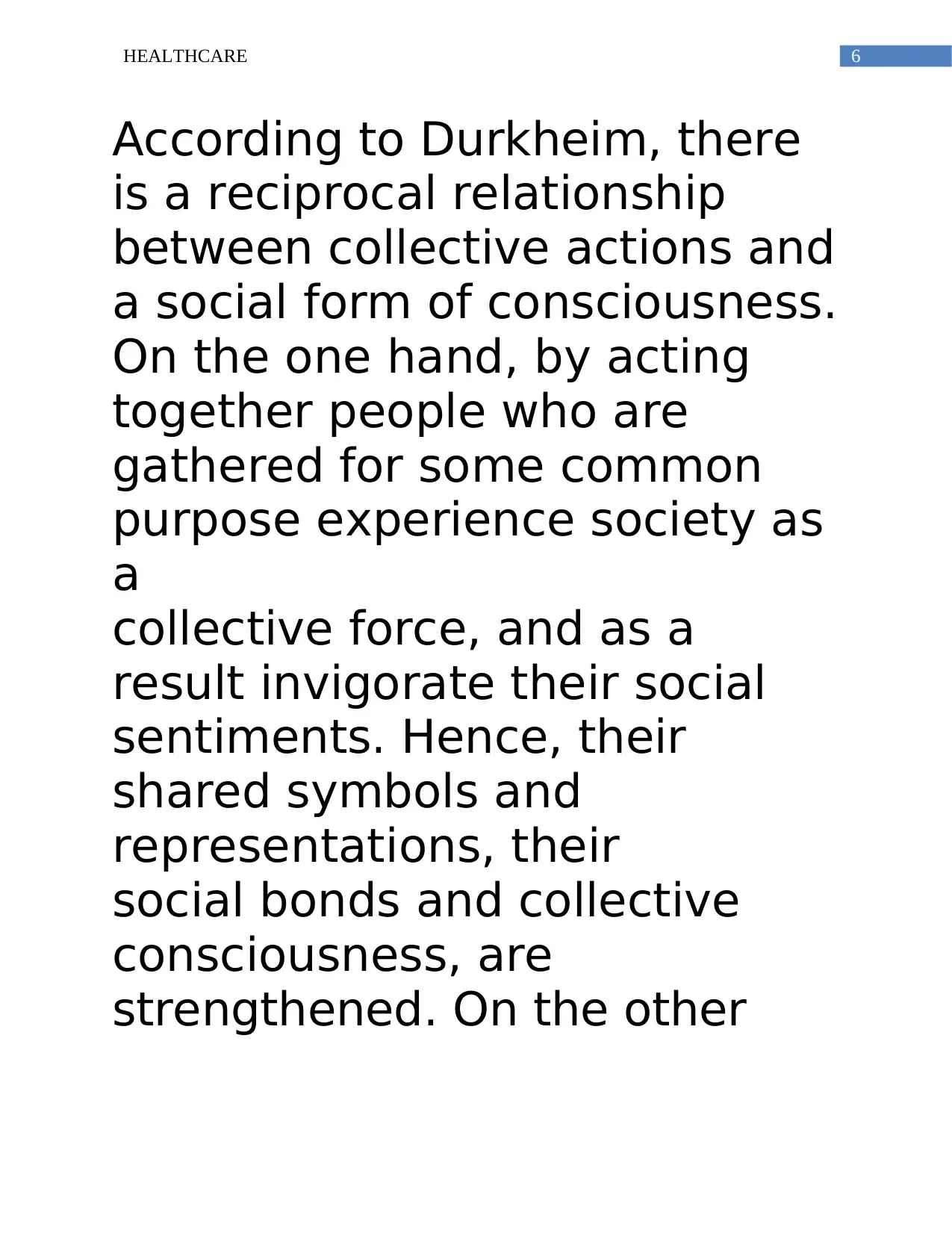
6HEALTHCARE
According to Durkheim, there
is a reciprocal relationship
between collective actions and
a social form of consciousness.
On the one hand, by acting
together people who are
gathered for some common
purpose experience society as
a
collective force, and as a
result invigorate their social
sentiments. Hence, their
shared symbols and
representations, their
social bonds and collective
consciousness, are
strengthened. On the other
According to Durkheim, there
is a reciprocal relationship
between collective actions and
a social form of consciousness.
On the one hand, by acting
together people who are
gathered for some common
purpose experience society as
a
collective force, and as a
result invigorate their social
sentiments. Hence, their
shared symbols and
representations, their
social bonds and collective
consciousness, are
strengthened. On the other
Paraphrase This Document
Need a fresh take? Get an instant paraphrase of this document with our AI Paraphraser
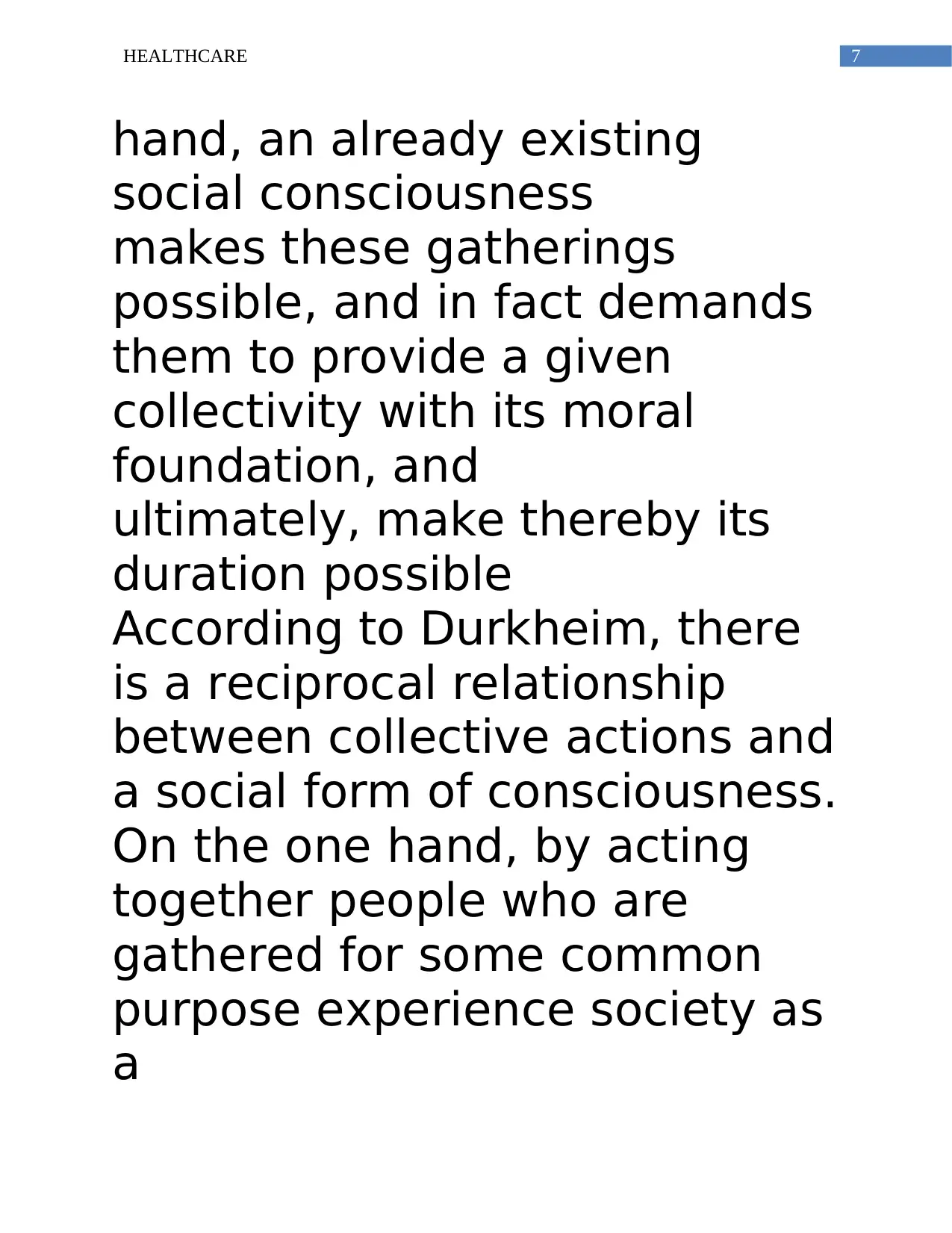
7HEALTHCARE
hand, an already existing
social consciousness
makes these gatherings
possible, and in fact demands
them to provide a given
collectivity with its moral
foundation, and
ultimately, make thereby its
duration possible
According to Durkheim, there
is a reciprocal relationship
between collective actions and
a social form of consciousness.
On the one hand, by acting
together people who are
gathered for some common
purpose experience society as
a
hand, an already existing
social consciousness
makes these gatherings
possible, and in fact demands
them to provide a given
collectivity with its moral
foundation, and
ultimately, make thereby its
duration possible
According to Durkheim, there
is a reciprocal relationship
between collective actions and
a social form of consciousness.
On the one hand, by acting
together people who are
gathered for some common
purpose experience society as
a
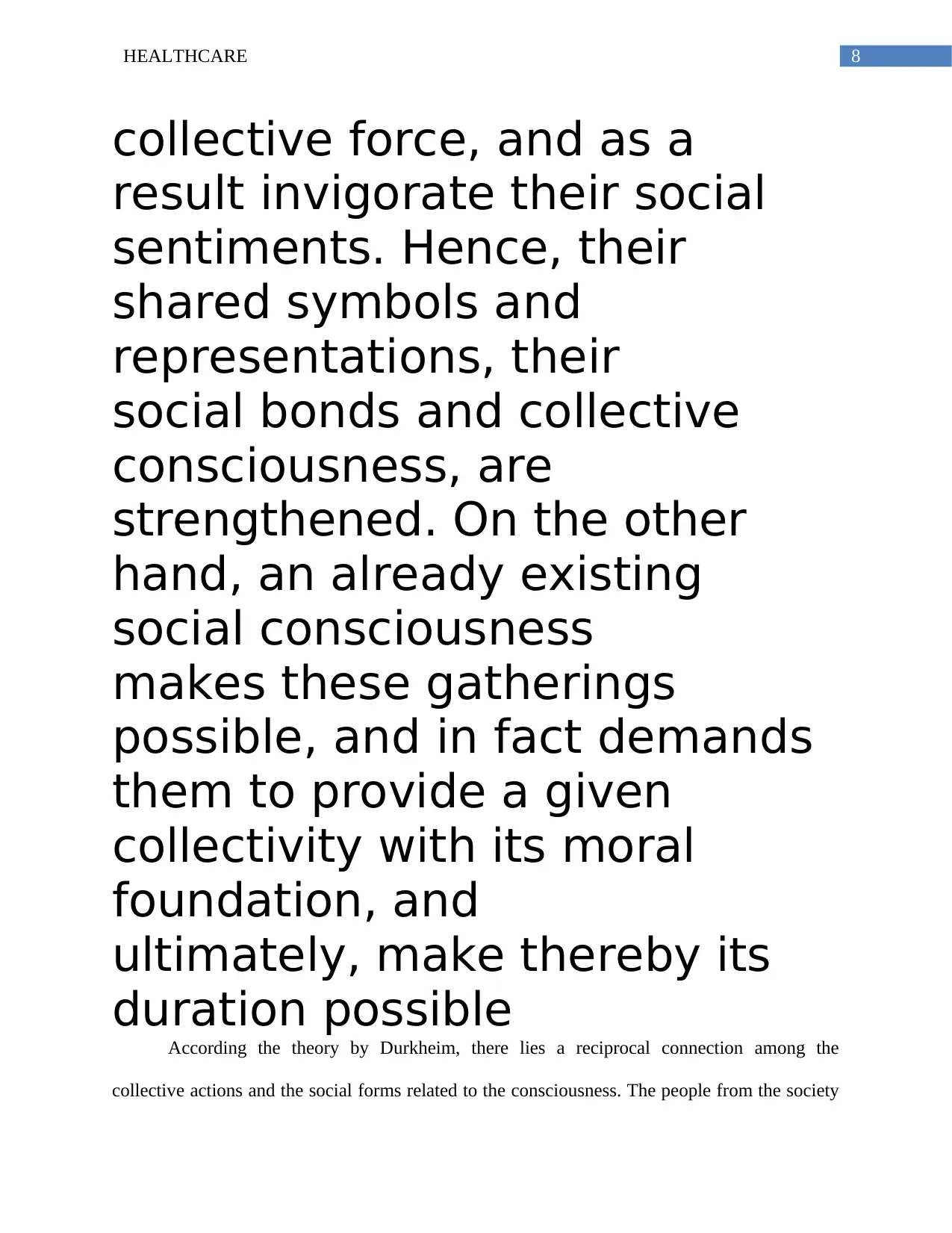
8HEALTHCARE
collective force, and as a
result invigorate their social
sentiments. Hence, their
shared symbols and
representations, their
social bonds and collective
consciousness, are
strengthened. On the other
hand, an already existing
social consciousness
makes these gatherings
possible, and in fact demands
them to provide a given
collectivity with its moral
foundation, and
ultimately, make thereby its
duration possible
According the theory by Durkheim, there lies a reciprocal connection among the
collective actions and the social forms related to the consciousness. The people from the society
collective force, and as a
result invigorate their social
sentiments. Hence, their
shared symbols and
representations, their
social bonds and collective
consciousness, are
strengthened. On the other
hand, an already existing
social consciousness
makes these gatherings
possible, and in fact demands
them to provide a given
collectivity with its moral
foundation, and
ultimately, make thereby its
duration possible
According the theory by Durkheim, there lies a reciprocal connection among the
collective actions and the social forms related to the consciousness. The people from the society
⊘ This is a preview!⊘
Do you want full access?
Subscribe today to unlock all pages.

Trusted by 1+ million students worldwide
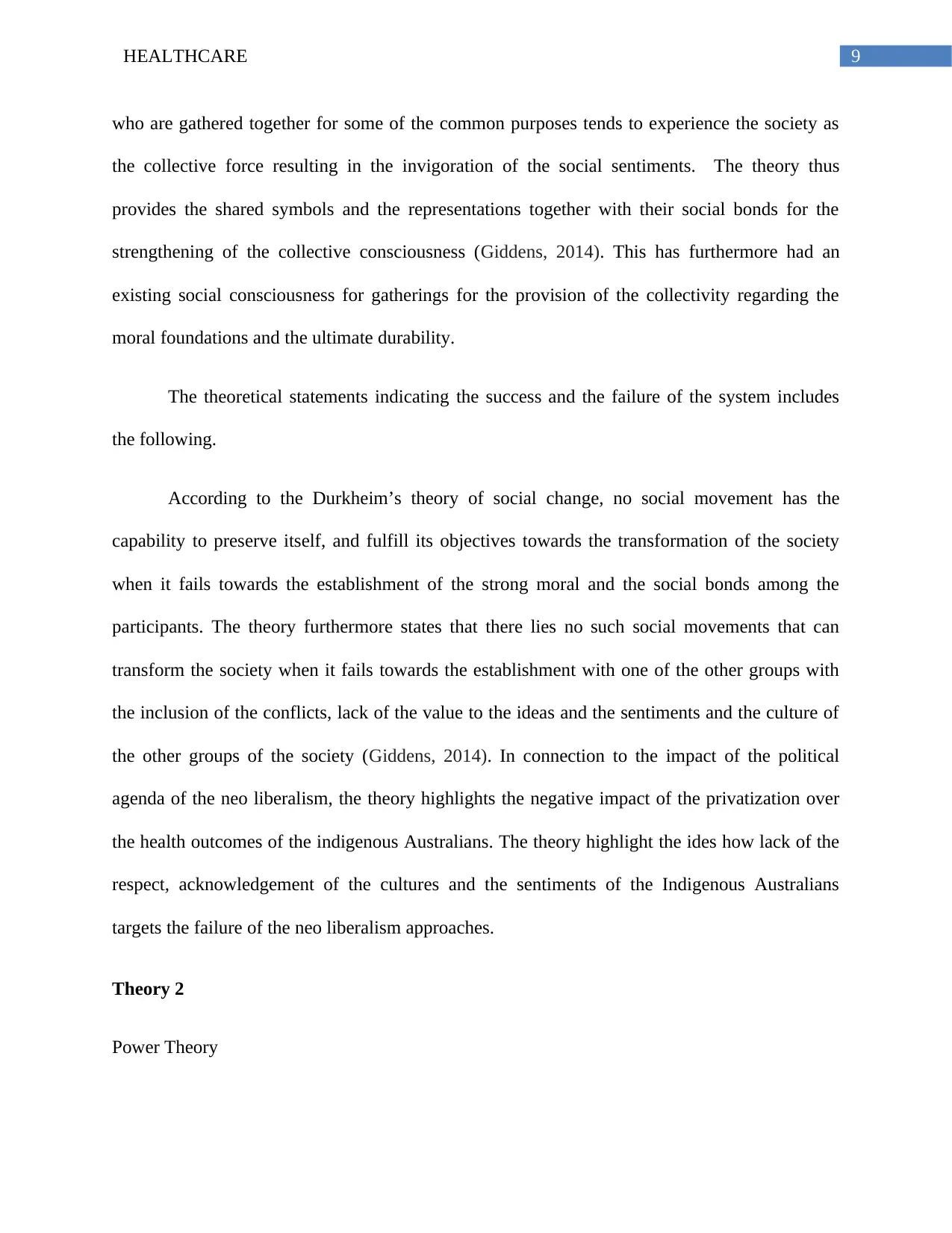
9HEALTHCARE
who are gathered together for some of the common purposes tends to experience the society as
the collective force resulting in the invigoration of the social sentiments. The theory thus
provides the shared symbols and the representations together with their social bonds for the
strengthening of the collective consciousness (Giddens, 2014). This has furthermore had an
existing social consciousness for gatherings for the provision of the collectivity regarding the
moral foundations and the ultimate durability.
The theoretical statements indicating the success and the failure of the system includes
the following.
According to the Durkheim’s theory of social change, no social movement has the
capability to preserve itself, and fulfill its objectives towards the transformation of the society
when it fails towards the establishment of the strong moral and the social bonds among the
participants. The theory furthermore states that there lies no such social movements that can
transform the society when it fails towards the establishment with one of the other groups with
the inclusion of the conflicts, lack of the value to the ideas and the sentiments and the culture of
the other groups of the society (Giddens, 2014). In connection to the impact of the political
agenda of the neo liberalism, the theory highlights the negative impact of the privatization over
the health outcomes of the indigenous Australians. The theory highlight the ides how lack of the
respect, acknowledgement of the cultures and the sentiments of the Indigenous Australians
targets the failure of the neo liberalism approaches.
Theory 2
Power Theory
who are gathered together for some of the common purposes tends to experience the society as
the collective force resulting in the invigoration of the social sentiments. The theory thus
provides the shared symbols and the representations together with their social bonds for the
strengthening of the collective consciousness (Giddens, 2014). This has furthermore had an
existing social consciousness for gatherings for the provision of the collectivity regarding the
moral foundations and the ultimate durability.
The theoretical statements indicating the success and the failure of the system includes
the following.
According to the Durkheim’s theory of social change, no social movement has the
capability to preserve itself, and fulfill its objectives towards the transformation of the society
when it fails towards the establishment of the strong moral and the social bonds among the
participants. The theory furthermore states that there lies no such social movements that can
transform the society when it fails towards the establishment with one of the other groups with
the inclusion of the conflicts, lack of the value to the ideas and the sentiments and the culture of
the other groups of the society (Giddens, 2014). In connection to the impact of the political
agenda of the neo liberalism, the theory highlights the negative impact of the privatization over
the health outcomes of the indigenous Australians. The theory highlight the ides how lack of the
respect, acknowledgement of the cultures and the sentiments of the Indigenous Australians
targets the failure of the neo liberalism approaches.
Theory 2
Power Theory
Paraphrase This Document
Need a fresh take? Get an instant paraphrase of this document with our AI Paraphraser
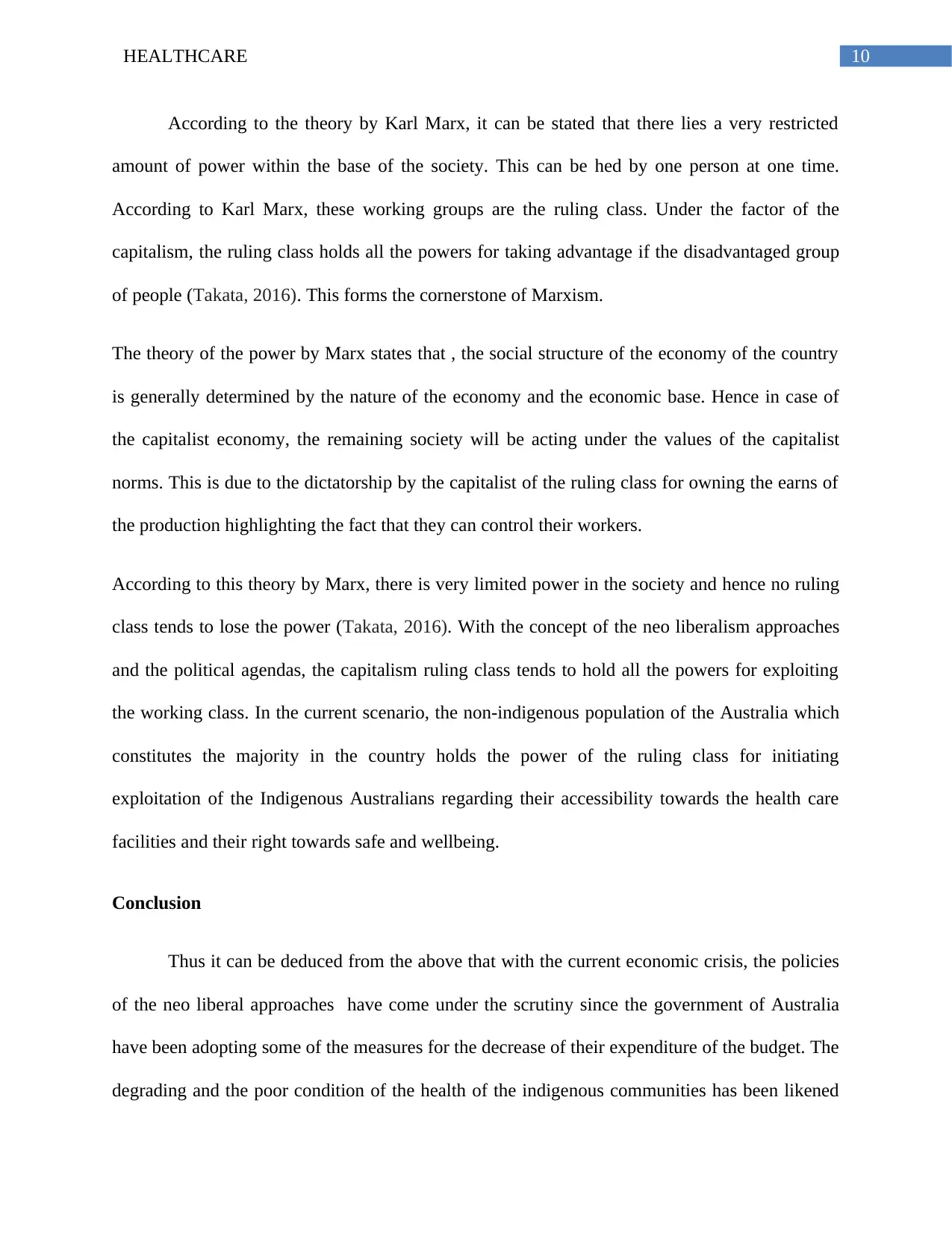
10HEALTHCARE
According to the theory by Karl Marx, it can be stated that there lies a very restricted
amount of power within the base of the society. This can be hed by one person at one time.
According to Karl Marx, these working groups are the ruling class. Under the factor of the
capitalism, the ruling class holds all the powers for taking advantage if the disadvantaged group
of people (Takata, 2016). This forms the cornerstone of Marxism.
The theory of the power by Marx states that , the social structure of the economy of the country
is generally determined by the nature of the economy and the economic base. Hence in case of
the capitalist economy, the remaining society will be acting under the values of the capitalist
norms. This is due to the dictatorship by the capitalist of the ruling class for owning the earns of
the production highlighting the fact that they can control their workers.
According to this theory by Marx, there is very limited power in the society and hence no ruling
class tends to lose the power (Takata, 2016). With the concept of the neo liberalism approaches
and the political agendas, the capitalism ruling class tends to hold all the powers for exploiting
the working class. In the current scenario, the non-indigenous population of the Australia which
constitutes the majority in the country holds the power of the ruling class for initiating
exploitation of the Indigenous Australians regarding their accessibility towards the health care
facilities and their right towards safe and wellbeing.
Conclusion
Thus it can be deduced from the above that with the current economic crisis, the policies
of the neo liberal approaches have come under the scrutiny since the government of Australia
have been adopting some of the measures for the decrease of their expenditure of the budget. The
degrading and the poor condition of the health of the indigenous communities has been likened
According to the theory by Karl Marx, it can be stated that there lies a very restricted
amount of power within the base of the society. This can be hed by one person at one time.
According to Karl Marx, these working groups are the ruling class. Under the factor of the
capitalism, the ruling class holds all the powers for taking advantage if the disadvantaged group
of people (Takata, 2016). This forms the cornerstone of Marxism.
The theory of the power by Marx states that , the social structure of the economy of the country
is generally determined by the nature of the economy and the economic base. Hence in case of
the capitalist economy, the remaining society will be acting under the values of the capitalist
norms. This is due to the dictatorship by the capitalist of the ruling class for owning the earns of
the production highlighting the fact that they can control their workers.
According to this theory by Marx, there is very limited power in the society and hence no ruling
class tends to lose the power (Takata, 2016). With the concept of the neo liberalism approaches
and the political agendas, the capitalism ruling class tends to hold all the powers for exploiting
the working class. In the current scenario, the non-indigenous population of the Australia which
constitutes the majority in the country holds the power of the ruling class for initiating
exploitation of the Indigenous Australians regarding their accessibility towards the health care
facilities and their right towards safe and wellbeing.
Conclusion
Thus it can be deduced from the above that with the current economic crisis, the policies
of the neo liberal approaches have come under the scrutiny since the government of Australia
have been adopting some of the measures for the decrease of their expenditure of the budget. The
degrading and the poor condition of the health of the indigenous communities has been likened
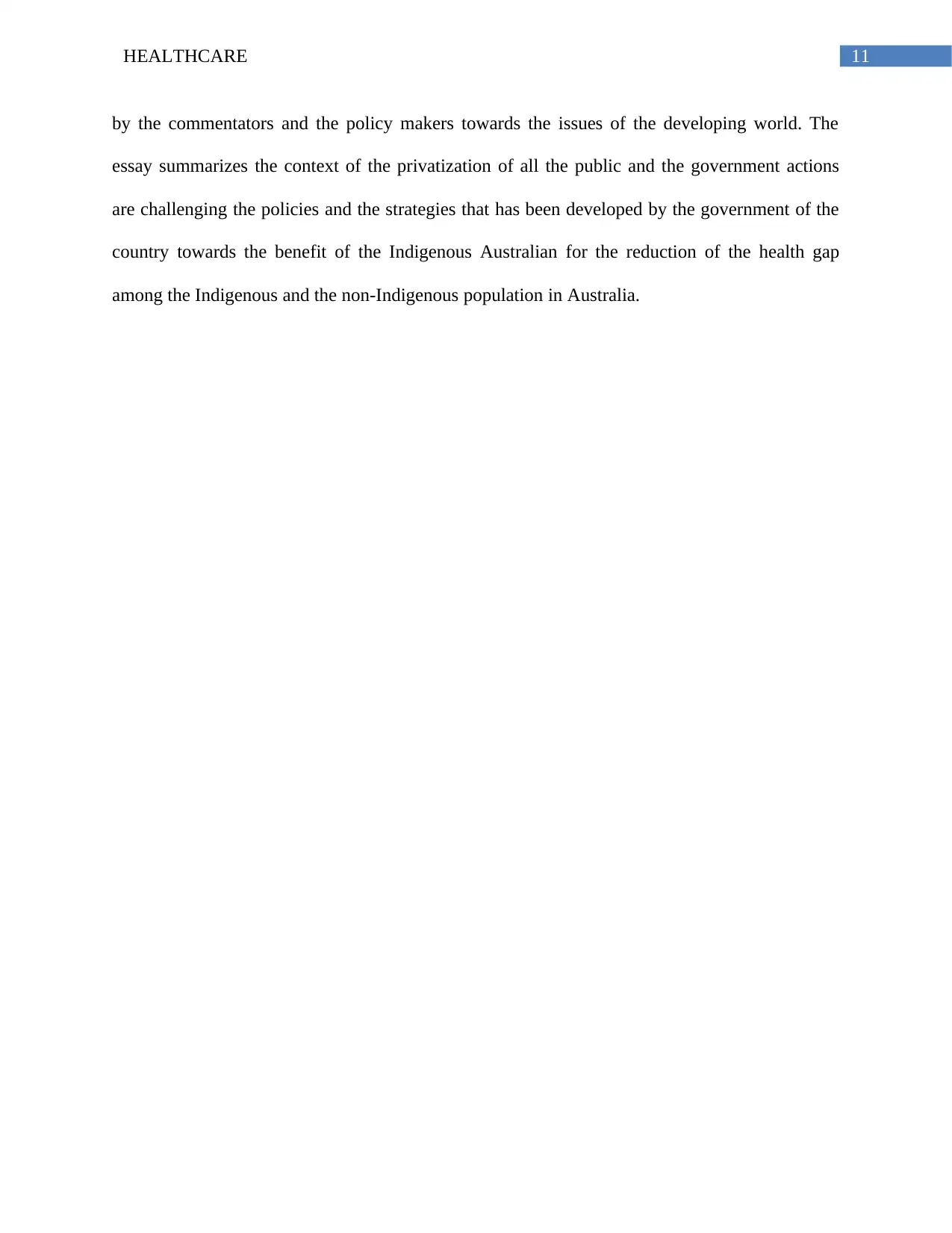
11HEALTHCARE
by the commentators and the policy makers towards the issues of the developing world. The
essay summarizes the context of the privatization of all the public and the government actions
are challenging the policies and the strategies that has been developed by the government of the
country towards the benefit of the Indigenous Australian for the reduction of the health gap
among the Indigenous and the non-Indigenous population in Australia.
by the commentators and the policy makers towards the issues of the developing world. The
essay summarizes the context of the privatization of all the public and the government actions
are challenging the policies and the strategies that has been developed by the government of the
country towards the benefit of the Indigenous Australian for the reduction of the health gap
among the Indigenous and the non-Indigenous population in Australia.
⊘ This is a preview!⊘
Do you want full access?
Subscribe today to unlock all pages.

Trusted by 1+ million students worldwide
1 out of 15
Related Documents
Your All-in-One AI-Powered Toolkit for Academic Success.
+13062052269
info@desklib.com
Available 24*7 on WhatsApp / Email
![[object Object]](/_next/static/media/star-bottom.7253800d.svg)
Unlock your academic potential
Copyright © 2020–2025 A2Z Services. All Rights Reserved. Developed and managed by ZUCOL.




